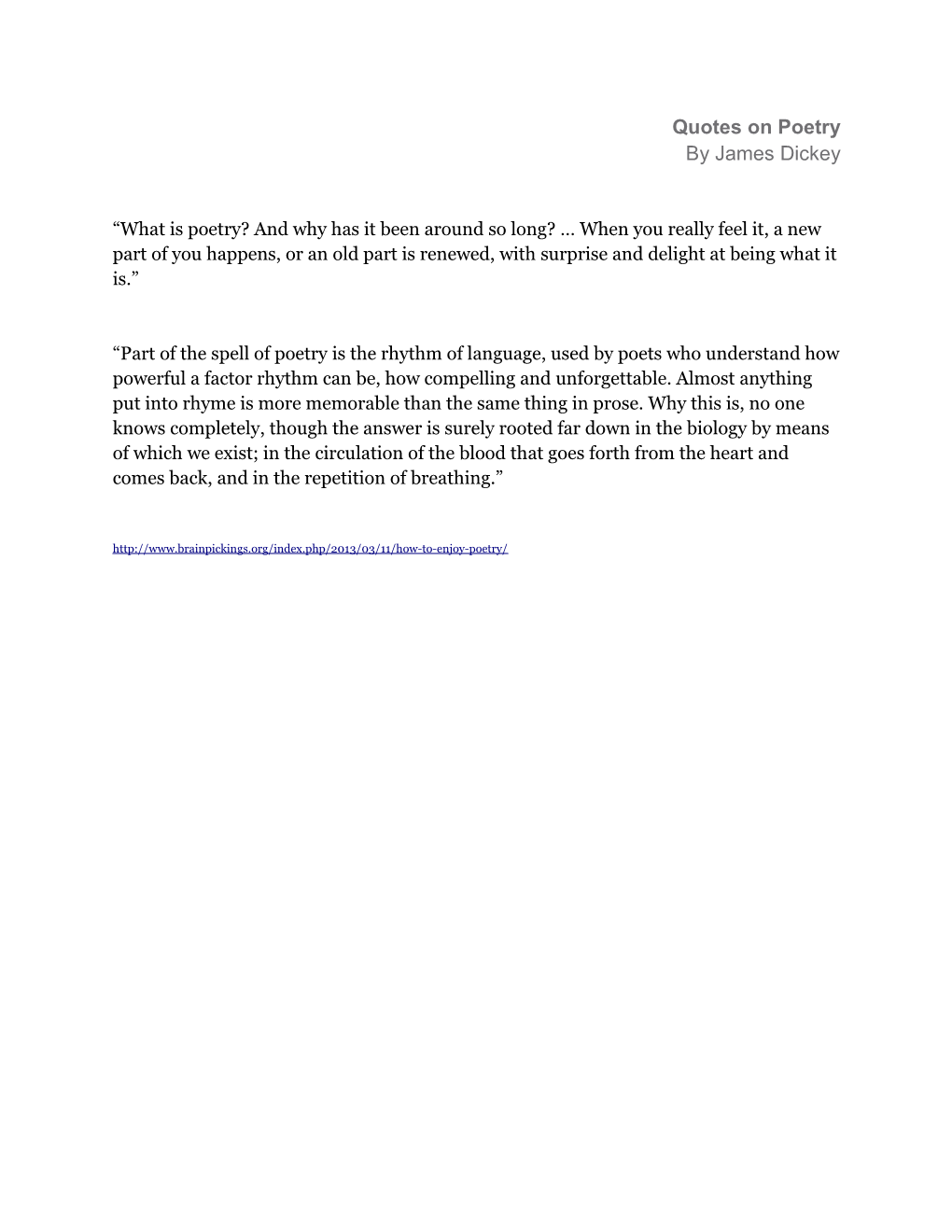Quotes on Poetry
By James Dickey
“What is poetry? And why has it been around so long? … When you really feel it, a new part of you happens, or an old part is renewed, with surprise and delight at being what it is.”
“Part of the spell of poetry is the rhythm of language, used by poets who understand how powerful a factor rhythm can be, how compelling and unforgettable. Almost anything put into rhyme is more memorable than the same thing in prose. Why this is, no one knows completely, though the answer is surely rooted far down in the biology by means of which we exist; in the circulation of the blood that goes forth from the heart and comes back, and in the repetition of breathing.”
Poet’s Toolbox Anchor Chart
Figurative Language / Sound / FormMetaphor / Alliteration / Line Length
Extended Metaphor / Onomatopoeia / Poetic Inversion
Simile / Repetition
Personification / Assonance
Allusion / Consonance
Apostrophe / Rhyme scheme
Vivid word choice
Juxtaposition
Poet’s Toolbox Reference Sheet
Name:Date:
Definition / Function / Example
Figurative Language / What is it? / How does it contribute to meaning? / What does it look like?
Metaphor / An implied comparison between two unlike things that have something important in common. / Clarifies the qualities of the thing the author is comparing—e.g., hope, like a bird, sings and gives happiness to a person. / Hope is a thing with feathers (Emily Dickinson)
Extended Metaphor / A metaphor that continues for several stanzas or the length of a poem / By using this device, the author can thoroughly examine the similarities between the two unlike things. / The Fog by Robert Frostis a short poem with extended metaphor.
Simile / A comparison using “like” or “as” between two unlike things that have something important in common / Same as metaphor / O my Love’s like a red, red rose, that’s newly sprung in June (Robert Burns)
Personification / A device where inanimate objects are given human characteristics / Helps the reader understand the purpose or visualize the inanimate object. Heightens the importance of the object. / The eyes of the old house watch me as I pass by (Sharon Ruebel)
Poet’s Toolbox Reference Sheet
Definition / Function / ExampleFigurative Language / What is it? / How does it contribute to meaning? / What does it look like?
Allusion / A device where the speaker refers to something that the reader needs prior knowledge of or experience with in order to understand. / It functions similarly to a metaphor. The reader can understand a complex concept quickly / This sports team is a Cinderella story!
Apostrophe / A device where the speaker talks directly to an absent person, living or dead, or even a nonexistent person or thing as if it was capable of understanding. / Heightens the emotion of the poem. / O, Death, be not proud (John Donne)
Vivid word choice / A device where the author chooses nouns, adjectives, or verbs that paint a strong mental picture and often have layers of meaning. / Helps the reader visualize the images. / Instead of saying “The dogs are mean,” the author says, “The dogs prowled, looking to attack.”
Juxtaposition / Placing two things that directly oppose each other (often abstract concepts) near each other or directly side-by-side so the reader can compare them. / Helps the reader see the differences and similarities between the two things being juxtaposed and come to a deeper understanding of both. / A Long Walk to Water,or Love is like a soft cushion to sleep on while Hate is a stone.
Poet’s Toolbox Reference Sheet
Definition / Function / ExampleSOUND / What is it? / How does it contribute to meaning? / What does it look like?
Alliteration / The repetition of beginning consonant sound / Creates rhythm, mood, and emphasizes the phrase. / Doubting, dreaming dreams no mortals ever dared to dream before (Edgar Allen Poe)
Onomatopoeia / Words that imitate the sound they are / Creates a strong mental image. / Bark, buzz, squishy
Repetition / When the author repeats something / Creates emphasis, rhythm, mood.
Assonance / Repetition of internal vowels / Helps create rhyme, mood, and musicality in a poem. / The crumbling thunder of seas (Robert Louis Stevenson)
Consonance / Repetition of ending (of the word or stressed syllable) consonant sound / Helps create rhythm and mood and emphasize a phrase. / Do not go gentle into that good night (Dylan Thomas)
Rhyme scheme / The pattern of rhyme in a poem / Creates rhythmic, memorable language and makes the poem “sing.” Also, when the pattern is broken, can create emphasis.
Poet’s Toolbox Reference Sheet
Definition / Function / ExampleFORM / What is it? / How does it contribute to meaning? / What does it look like?
Line length / The numbers of words in a line / Short lines can provide emphasis or give a choppy feel to the rhythm. On the other hand, long lines can heighten emotion.
Poetic Inversion / When a poet deliberately writes a sentence in a grammatical unusual way / Catches the reader’s attention, highlights the information in the line, or keeps the rhythm of the poem. / Like men, we’ll face the murderous, cowardly pack. (Claude McKay)
Lines from “If We Must Die” by Claude McKay
While round us bark the mad and hungry dogs,
Making their mock at our accursèd lot.
McKay, Claude. “If We Must Die.” Poetry.org. Web.
Model Found Poem Draft 2
Mother
She journeyed to see me in the night
Immune to the weariness in her bones
While the moon illuminated her solitary walk.
Lyingbeside me
Like embers,
Like stones slowly baked by the sun,
Like the blanket she wished she could be.
Never by thelight of day
Whipping—the penalty
But worse yet,
Even in death,
She was astranger
to me.
That distance
Her feet couldn’t cross.
Although led by her motherly heart,
she tried.
